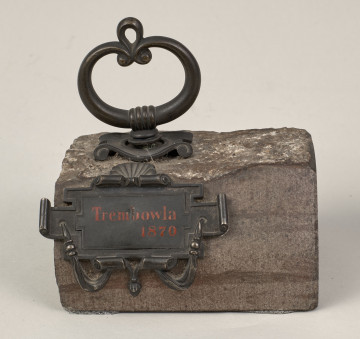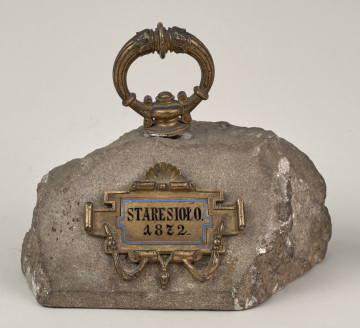
Paperweight
XIX century
Castle Museum in Łańcut
Part of the collection: Weapons, music instruments, varia
One of the basic characteristics of man that distinguishes him from an animal is speech. However, the spoken word is impermanent, and human memory is unreliable. The invention that allowed for the accumulation and transmission of knowledge, culture and civilization to the next generations was writing, the development of which progressed very slowly.
At the end of the Stone Age, people began to convey information by means of pictures – symbols. Such pictographic notations developed into pictorial and phonetic writing that allowed to be written in a specific language. Scholars believe that writing arose with the development of urban civilization, which began to flourish in the Middle East around 4000 B.C.E (writing laws, contracts). In the following centuries, cuneiform writing (Mesopotamia) and hieroglyphic writing (Egypt) were created. A breakthrough in the history of writing was the invention and dissemination of the alphabet, i.e. a notation of sounds. Alphabetic writing, in which individual odds correspond to separate characters (letters), appeared in Palestine in the second half of the second millennium B.C.E. Over the next millennium, alphabetic writing underwent numerous transformations, so that by 1000 B.C.E. the Phoenician alphabet could be considered fully formed. From the Phoenicians, the alphabetic notation was taken over by the Greeks, from whom the name alphabet (alpha, beta – the first alphabet used by them) is derived, and the Romans gave it the form we use today. The spread of alphabetic writing resulted in a massive demand for stationery. Attempts were made to write on wood, bone, bark, palm leaves. It was not until the Egyptians that the stems of the papyrus, tree growing in the Nile Delta that were used to make papyrus. The next milestone in writing was the invention of parchment made from animal skins. The origin of Pergamon and its name is connected with the city of Pergamon in Asia Minor, which for years was an important centre of parchment production and trade. Both of these writing materials (papyrus and parchment) were very expensive and their production was time-consuming, which resulted in the exclusivity of all kinds of documents, books, the possession of which was associated with financial capacity. Until the 15th century, all documents were handwritten with the use of sharpened sticks, bird feathers and brushes (the Far East). Feathers plucked from live birds were sintered in hot sand or burned in some other way so that the membrane covering them could be lightly removed. Then they were drowning in alum or acid to gain hardness. Thanks to such tools, ink was applied to papyrus and pergamon to create documents. The Greek word kalomos, the Latin calamus and calamrium gave the name “inkwell” to describe a vessel of ink. Ink is a solution or suspension of a natural or synthetic dye with the addition of glycerine, gum arabic and preservatives. The first inks were black, brown, sometimes with a greenish tinge. Red ink began to be used to mark initials or titles (the colour was obtained by adding mini), and after the addition of gold or silver, the colour of these precious metals was obtained. A breakthrough in the history of writing in Europe was the importation (some experts attribute this fact to Morco Polo) of paper, which had been known in China since the beginning of Common Era. The first paper mills (paper mills) were established in Spain in the vicinity of Valencia. In the middle of the thirteenth century the Italian town of Faleriano near Ancona became a centre of the production of high-quality paper. In the second half of the fifteenth century paper mills existed in Poland. The fifteenth century is characterized by a significant demand for the written word (the Reformation and the Counter-Reformation contributed to the creation of many theological works available to a wider audience). This demand could not be met by the previous method of copying works by hand in monasteries or by copying texts by hand in the chancelleries of rulers. The search for a new way of writing led to the "invention" of printing and the use of movable type. Although in 1041 C.E. a Chinese blacksmith was the first in the world to invent and use movable type for single characters, in Europe the Dutchman Laurens Janszoon Coster, who operated in the city of Haarlem, is considered to be the inventor. Despite this fact, Johannes Gutenberg is considered to be the creator of printing (in the minds of Europeans), and the Bible printed by him (the Gutenberg Bible) has become a symbol of progress in the consciousness of modern man. The introduction of movable type, more and more efficient printing presses, new means (printing inks) spread the art of writing and reading and additionally developed into the printing of drawings and pictures. Flat printing was the first to be used for illustration, followed by intaglio and relief printing. The difference between the intaglio and relief printing is that in relief printing, the drawing or inscription is on the surface of the matrix, while in the intaglio it is below the surface. The gravure printing technique (an example is the matrix no. S.3729MŁ, discussed below) has gained more popularity due to its resistance to damage, thanks to which it has been possible to print larger quantities. To put it simply, intaglio printing means that the printing places are located lower than the non-printing places, the printing ink is applied to both places (fields) and then the printing ink is collected with a doctor blade (a special tool) from the non-printing places. In this simple way, the ink remains only in the recessed places and transfers the pattern and inscription to the sheet of paper through the printing process. The object described in the inventory books, rather unfortunately classified as a paperweight (the weight and form are not suitable for such a purpose) is an example of a variant of flat printing, i.e. stone engraving, where the printing form is a graphic stone with an engraved drawing or inscription. In this case, the stone has the inscription "La contesseAlferd Potocka neeprincessa Czartoryska" ("Princess Alfred Potocka née Czartoryska"). The inscription (in the negative) is placed in a frame, which suggests that it was a matrix of a visiting card. A visiting card (a calling card) is usually a rectangular, handy, piece of paper with the content.e.g., the name and surname of the owner of this type of card. Again, we must return to China, which in the fifteenth century became the cradle of the visiting card, where the official was obliged to possess a visiting card by decree of the emperor. Calling cards became popular in Europe during the reign of Louis XIV and in Russia under Catherine II. The visiting card, the matrices of which we are discussing, belonged to Alfred I Potocki's wife, Józefina Maria Czartoryska. The wedding of Józefina and Alfred took place on 21 June 1814, when Alfred, returning from Russian captivity (Alfred, as an officer of the Duchy of Warsaw, was wounded and taken sa a prisoner in the Battle of Borodino), stayed at the estate of Józef Klemens Czartoryski in Antoniny. It is worth reminding here that Alfred and Józefina Potocki continued their work in the Łańcut castle and we owe them the extension and decoration of the rooms on the second floor of the palace.
Today it is difficult to say what the exact function of the matrix was, maybe it was part of a larger whole, or it was preserved as a paperweight, but it is certainly a memento of the owners of Łańcut.
Przemysław Kucia
Author / creator
Object type
pamiątki
Material
stone, marble
Creation time / dating
Owner
Muzeum - Zamek w Łańcucie
Identification number
Location / status

XIX century
Castle Museum in Łańcut

XIX century
Castle Museum in Łańcut

XIX century
Castle Museum in Łańcut
DISCOVER this TOPIC
Museum of King Jan III's Palace at Wilanów
DISCOVER this PATH
Educational path